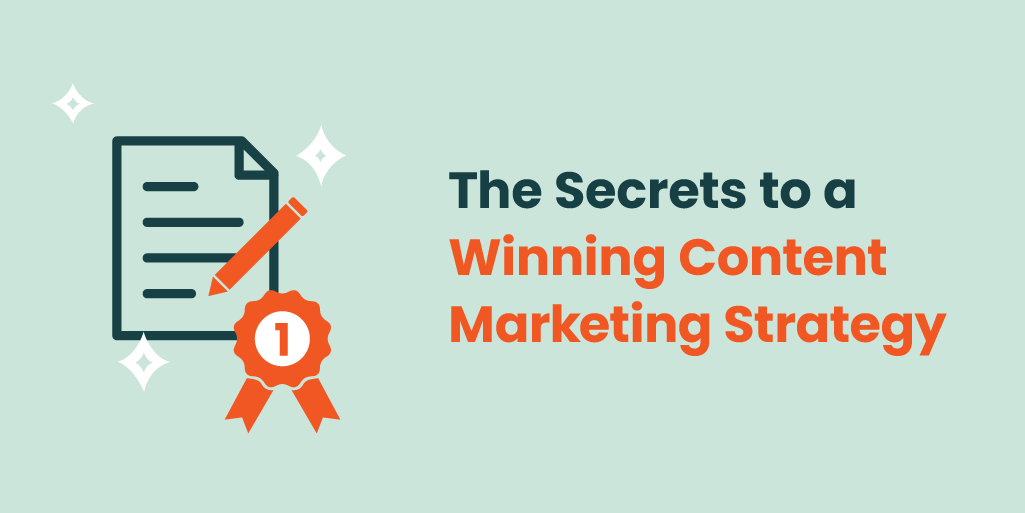Let’s be real, content marketing is hard. So it’s not surprising that more than half (58%) of B2B marketers rate their content marketing strategy as just “moderately effective.” Nearly half of those say their strategy struggles because they lack clear goals, and only one in three say they have a scalable model for content creation.
In other words, 58% of B2B marketers are treading water, half don’t know where they’re swimming, and only a third have a boat.
So, take solace knowing you’re not alone. But you don’t have to stay stuck, no matter how budget- or time-constrained you may be. Let’s break down some advice, examples, and best practices so you can create and execute a content marketing strategy that delivers real value.
What Does a Good Content Marketing Strategy Look Like?
It’s simpler than you might think: It maps back to your biggest business objectives. Yet, this is where lots of content marketers make a big mistake. They crank out blog posts, emails, and social posts without considering how these assets help the company reach its goals. Sure, the content marketing calendar is full, but is it the most valuable use of your time? It’s like buying a bunch of random groceries with no plan for dinner. You may have a full refrigerator but can you actually make a meal?
If you’re strategizing from scratch, ask these 8 questions:
- What is the business trying to achieve?
Maybe it’s more brand awareness. Or maybe it’s accelerating your sales cycle. Or maybe it’s taking market share from a giant competitor. Each of these scenarios requires a different buyer journey, and thus, different content. - What are you being graded on?
Being tasked with generating 30 leads a month comes with a different path forward than narrowing the company’s marketing focus to a few priority verticals or expanding your target audience to include CIOs. - Why does your organization win and lose deals?
Many marketers don’t know the answer to this because they think it’s a Sales-only issue. But knowing why prospects ultimately say “yes” or “no” gives you tremendous fodder for new content. - What are the most common questions your sales team gets?
There are typically a handful of questions that Sales gets over and over. If you can create content that answers them, Sales doesn’t have to spend as much time educating prospects, which will shorten your sales cycle. - What are the most frequent objections to sale?
Once again, combatting these with your content reduces the time Sales has to spend on prospect education. - Where do you have content gaps?
A content marketing audit is worth its weight in gold. You may discover a lack of content in one particular part of the funnel. Or, you may see that there’s no content aimed at a specific persona. Virtually every organization has gaps, so go find them and fill them. - What’s performing best?
Look at GA4 and your CRM to see which formats and topics are getting the most engagement. Then, double down on what works. - What is your competition doing?
Your ideal buyers are consuming content from lots of organizations that offer similar solutions. It’s not about copying them — it’s about knowing what you’re up against so you can strategize accordingly.
How Do You Scale Your Content Marketing Strategy?
Every content marketer should ask themselves, “Is what I’m doing today scalable?” Scaling up doesn’t require more people — it means squeezing every bit of juice from every asset you create. I always say that content is a process, not a project. In other words, you shouldn’t be thinking in terms of one-off deliverables. Instead, you should be thinking about how the assets you create feed other assets.
For example, pull the most interesting statistics from that whitepaper you wrote and use them to create an infographic and some social cards. Both will have a CTA to download the whitepaper, and just like that, you’re guiding your audience down the funnel.
Or, take that long case study you wrote and create a one-page version of it that’s highly visual and easy to scan. Then, use the quotes for testimonials on your website and in social posts. Just like that, you have several easily digestible assets to impress busy executives who don’t have time to read the long story.
This strategy applies to video content marketing too. At first thought, an $8,000 or $10,000 explainer video can seem like a ton of spend for limited value. That’s why startup marketers are often surprised when I tell them all the ways they can use a single explainer video:
- They can use 0:15 or 0:30 snippets for organic social and YouTube Shorts.
- They can use those same snippets for LinkedIn ads, then retarget the people who watched them with another offer that’s further down the funnel.
- They can use the full video in an ad and retarget people who watched 25%, 50%, or 100% of it.
- In addition to being featured prominently on your homepage, the full version is a great way to succinctly show potential investors what you do and why it’s valuable.
Yes, AI Belongs in Your Content Marketing Strategy (But Use It Wisely)
The most effective content marketers keep their eyes peeled for new tools and leverage them the right way. This is where you can make massive efficiency gains. For example, give ChatGPT a list of your most popular blog posts and ask for related topic ideas. (But please, please, please don’t ask ChatGPT to write the actual posts. Readers can smell that shortcut from a mile away.)
Or, after you’ve written your monthly newsletter, ask ChatGPT to write five subject lines for it. While you should always edit the output before using it, it’s a great way to see an assortment of catchy angles that you may not have thought of — and certainly wouldn’t have thought of so quickly. The same goes for headlines on your landing pages and titles of your blog posts. After all, in startup world, every minute you can save is precious!
Your Next Step
If this sounds like a lot, don’t panic. Start with the 8 questions and figure out what your most immediate needs are. There are always must-haves and nice-to-haves. Sure, it would be great to start a YouTube channel, but if you don’t have any lead generation magnets, YouTube will have to wait. By tackling the most important to-dos first, you’ll start to move the needle. And that’s what’s most important — generating genuine value for your organization.
If you need a helping hand — either with your initial content marketing strategy or executing it — Firebrand’s content marketing experts are always here. We love helping startups crush their marketing goals.
About the Author
Nicole Pytel is Vice President of Content Marketing at Firebrand Communications, leads Firebrand's Content Marketing team, and is one of the hosts of Firebrand's podcast FiredUp!
After starting her career as a TV journalist, Nicole has spent the past 15 years driving growth for B2B companies of all sizes, from scrappy startups to the Fortune 25. With deep expertise across brand positioning, go-to-market strategy, content development, and demand generation, Nicole helps tech brands turn breakthrough ideas into compelling, scalable content marketing programs.
Follow Nicole on LinkedIn, listen to her on FiredUp!, or read her insights on Firebrand's B2B tech marketing blog.




